To calculate your Water Tank Capacity, enter the following details given below:
Water Tank Capacity Calculator
Select a tank shape, enter dimensions and units -- results show total volume and partial-fill (where supported).
Quick Navigation
What is a Water Tank Capacity Calculator?
A water tank capacity calculator is a simple free online tool that helps you figure out how much liquid a tank can hold. Instead of guessing, you have to enter the tank’s dimensions: length, width, height, diameter or depth depending on the shape and the calculator does the math instantly and give you results.
People use it for all sorts of things. Maybe you’re sizing a storage tank for rainwater harvesting Or you are a contractor who needs to check if a cylindrical tank will fit a client’s daily water demand. Farmers often rely on it for livestock water tanks, while some homeowners just want to know if their tank is big enough for daily household use.
Without a calculator, you’d be stuck scribbling formulas on paper or searching through geometry textbooks But with the help of this tool, you just have to enter the values and when you tap on calculate you will get the results in liters, gallons and cubic feet.
Types of Water Storage Tanks
Not all tanks are shaped the same way and that’s where a water tank capacity calculator really shines. Tanks can be simple boxes, tall vertical cylinders or even complex shapes like capsules and cone bottom designs. Each type requires its own formula to correctly calculate how much liquid it can hold
Here’s a simple guide to the most common water tank shapes and how people use them:
- Rectangle (Rectangular Prism or Box): A basic non curved shape with flat surfaces.
- Commonly used for small household water tanks, aquariums and storage containers because they’re easy to build and install.
- Vertical Cylinder: A cylindrical tank standing upright.
- Widely used for water towers, rainwater harvesting and industrial storage, since they take up less ground space.
- Horizontal Cylinder: A cylindrical tank lying on its side.
- Often used in transportation (trucks, trailers) and for fuel or liquid storage where stability is needed.
- Vertical Capsule: A vertical version of the capsule tank.
- Useful for space saving vertical storage in factories or plants where durability is important.
- Horizontal Capsule: A cylinder with rounded ends, lying on its side.
- Popular in liquid transport and chemical industries since the rounded ends reduce stress points.
- Vertical Oval: An oval-shaped tank standing upright.
- Suitable for basements, factories or tight indoor spaces where width is limited but height is available.
- Horizontal Oval: An oval-shaped tank lying sideways.
- Handy for limited height spaces like under decks or in crawl areas where a round cylinder won’t fit.
- Horizontal 2:1 Elliptical: A special elliptical shape with a 2:1 aspect ratio, often seen in tank heads.
- Common in pressure vessels and industrial tanks offering strength while saving material.
- Horizontal Ellipse: An elliptical cross-section tank, horizontally oriented.
- Used in transport and process industries as the flatter design lowers the center of gravity.
- Vertical Oval Stadium: A vertically standing tank with a “stadium” cross-section (a rectangle with semicircle ends).
- Useful in factories or buildings where a tall, slim profile is needed but with more capacity than a plain oval.
- Horizontal Oval Stadium: A horizontally oriented tank with a “stadium” cross-section.
- Often chosen for transport and storage in low clearance areas since the flat sides allow stacking or fitting in tighter spaces.
- Horizontal Dish Ends: Cylindrical tank with dished (curved) end caps.
- Found in high-pressure storage, chemical plants and breweries, as the dish ends handle pressure better.
- Spherical: A perfectly round tank.
- Typically used for large scale gas storage (like LPG or LNG) due to uniform stress distribution.
- Cone Bottom: A vertical cylindrical tank with a conical base.
- Common in food processing, wastewater treatment and brewing, since the cone allows complete drainage.
Water Tank Capacity Calculation Formula
When designing or using a water tank, knowing its storage capacity is important for proper planning in homes, industries or in agriculture. The capacity depends on the tank’s shape and can be calculated using standard formulas of geometry. The following sections explain the formulas for different tank types with solved examples and results converted into liters for easy understanding.
Here’s a quick breakdown of the formulas used in the calculator for different shapes:
1: Rectangular Prism
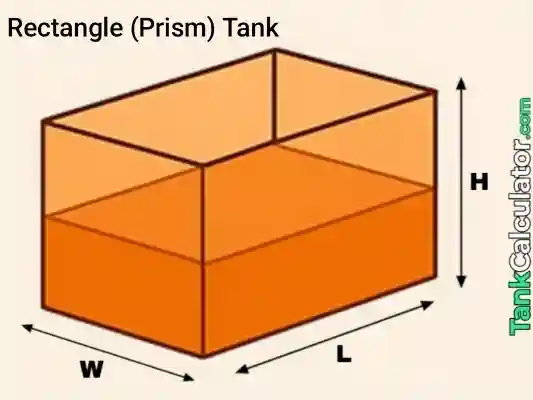
Formula: \( V = L \times W \times H \)
Example inputs: \( L = 0.8 \, \text{m}, W = 0.6 \, \text{m}, H = 0.5 \, \text{m} \)
Calculation:
- \( 0.8 \times 0.6 = 0.48 \)
- \( 0.48 \times 0.5 = 0.24 \, \text{m}^3 \)
Convert to liters: \( 0.24 \times 1000 = 240.000 \, \text{L} \)
2: Vertical Cylinder
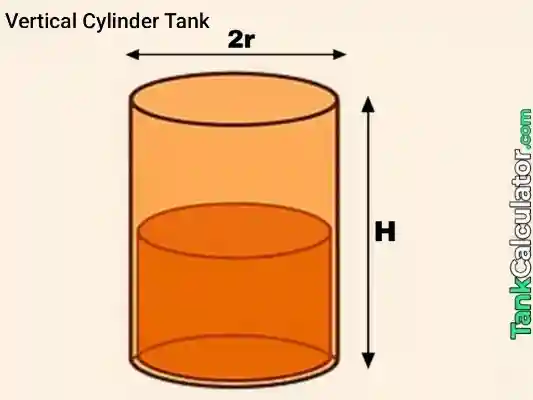
Formula: \( V = \pi \left(\frac{D}{2}\right)^2 H \)
Example inputs: \( D = 0.6 \, \text{m}, H = 1.0 \, \text{m} \)
Calculation:
- \( r = D/2 = 0.6/2 = 0.3 \, \text{m} \)
- \( r^2 = 0.3^2 = 0.09 \)
- \( \pi r^2 H = \pi \times 0.09 \times 1.0\)
- \(= 0.2827433388 \, \text{m}^3 \)
Convert to liters: \( 0.2827433388 \times 1000 = 282.743 \, \text{L} \)
3: Horizontal Cylinder
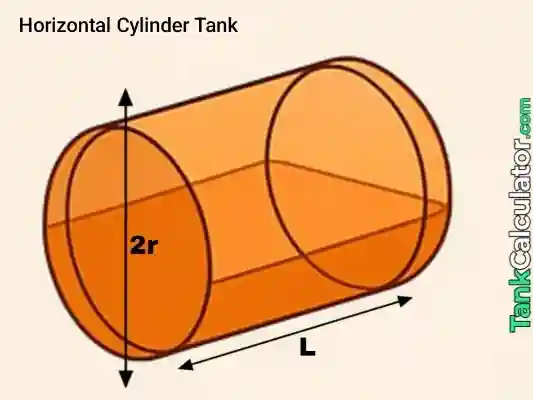
Formula: \( V = \pi \left(\frac{D}{2}\right)^2 L \)
Example inputs: \( D = 0.5 \, \text{m}, L = 1.0 \, \text{m} \)
Calculation:
- \( r = 0.25 \, \text{m} \)
- \( r^2 = 0.0625 \)
- \( \pi \times 0.0625 \times 1.0\)
- \( = 0.1963495408 \, \text{m}^3 \)
Convert to liters: \( 0.1963495408 \times 1000 = 196.350 \, \text{L} \)
4: Vertical Capsule
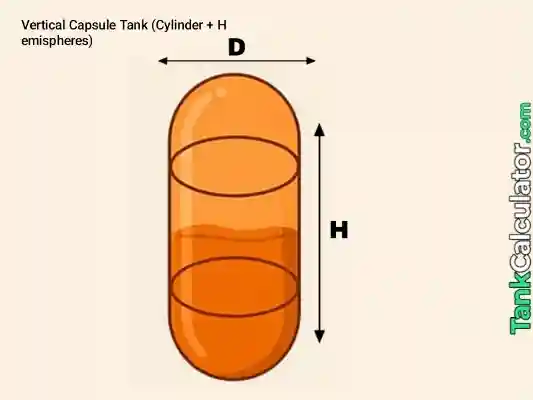
Formula: \( V = \pi r^2 H_c + \frac{4}{3} \pi r^3 \) where \( r = D/2 \)
Example inputs: \( D = 0.5 \, \text{m}, H_c = 0.6 \, \text{m} \)
Calculation:
- \( r = 0.25 \, \text{m} \)
- Cylinder: \( \pi r^2 H_c = \pi \times 0.0625 \times 0.6\)
- \( = 0.1178096885 \, \text{m}^3 \)
- Hemispheres combined = sphere: \( \frac{4}{3} \pi r^3 = \frac{4}{3} \pi \times 0.015625 \)
- \(= 0.0654498829 \, \text{m}^3 \)
Total: \( 0.1178096885 + 0.0654498829\)
\( = 0.1832595714 \, \text{m}^3 \)
Convert to liters: \( 0.1832595714 \times 1000 = 183.260 \, \text{L} \)
5: Horizontal Capsule
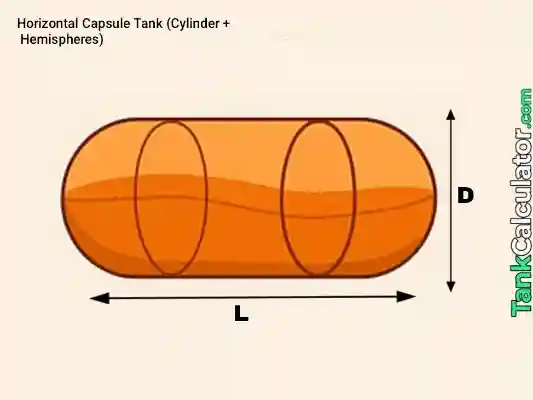
Formula: \( V = \pi r^2 L_c + \frac{4}{3} \pi r^3 \)
Example inputs: \( D = 0.45 \, \text{m}, L_c = 0.8 \, \text{m} \)
Calculation:
- \( r = 0.225 \, \text{m} \)
- \( r^2 = 0.050625 \)
- Cylinder: \( \pi \times 0.050625 \times 0.8 \)
- \(= 0.1274971969 \, \text{m}^3 \)
- Hemispheres combined: \( \frac{4}{3} \pi r^3 = 0.0474502440 \, \text{m}^3 \)
Total: \( 0.1274971969 + 0.0474502440\)
\( = 0.1749474409 \, \text{m}^3 \)
Convert to liters: \( 0.1749474409 \times 1000 = 174.947 \, \text{L} \)
6: Vertical Oval (Elliptical cross-section)
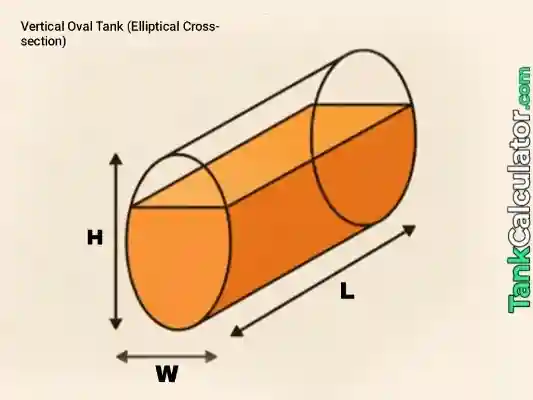
Formula: \( V = \pi \times \frac{W}{2} \times \frac{H}{2} \times L \)
Example inputs: \( W = 0.8 \, \text{m}, H = 0.5 \, \text{m}, L = 0.6 \, \text{m} \)
Calculation:
- \( a = W/2 = 0.4, b = H/2 = 0.25 \)
- Cross section area: \( \pi ab = \pi \times 0.4 \times 0.25 \)
- \(= 0.3141592654 \, \text{m}^2 \)
- Volume: \( 0.3141592654 \times 0.6\)
- \( = 0.1884955592 \, \text{m}^3 \)
Convert to liters: \( 0.1884955592 \times 1000 = 188.496 \, \text{L} \)
7: Horizontal Oval (Elliptical cross-section)
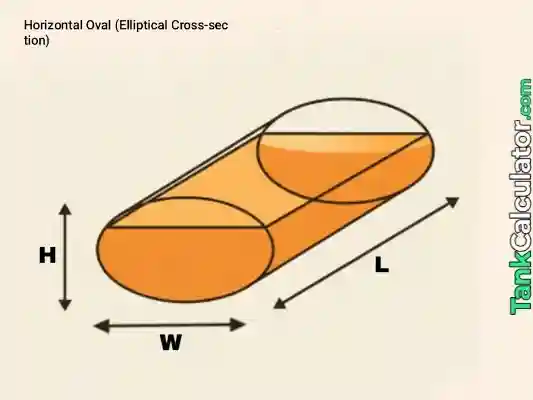
Formula: \( V = \pi \times L \times \frac{W}{2} \times \frac{H}{2} \)
Example inputs: Width (\( W \)) = 0.9 m, Height (\( H \)) = 0.4 m, Length (\( L \)) = 0.7 m
Calculation:
- Radii: \( a = \frac{W}{2} = \frac{0.9}{2} = 0.45 \, \text{m} \), \( b = \frac{H}{2} = \frac{0.4}{2} = 0.2 \, \text{m} \)
- Cross sectional area: \( \pi \times 0.45 \times 0.2 \)
- \(\approx 0.2827433388 \, \text{m}^2 \)
- Volume: \( 0.2827433388 \times 0.7 \)
- \(\approx 0.1979203372 \, \text{m}^3 \)
Convert to liters: \( 0.1979203372 \times 1000 \approx 197.920 \, \text{liters} \)
8: Horizontal 2:1 Elliptical (major = 2 × minor)
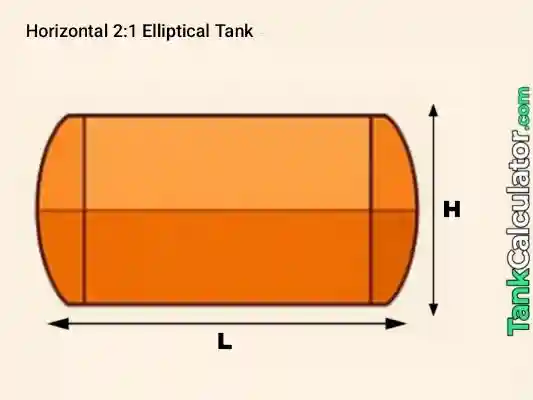
Formula: If minor = \( h \) and major = \( 2h \), \( V = \frac{\pi}{2} h^2 L \) (derived from \( \frac{\pi h}{2} \frac{L}{2} \))
Example inputs: \( h = 0.4 \, \text{m (minor)}, L = 1.2 \, \text{m} \)
Calculation:
- \( h^2 = 0.16 \)
- \( V = \frac{\pi}{2} \times 0.16 \times 1.2 \)
- \(= 0.3015928947 \, \text{m}^3 \)
Convert to liters: \( 0.3015928947 \times 1000 = 301.593 \, \text{L} \)
9: Horizontal Ellipse (General Elliptical Cylinder)
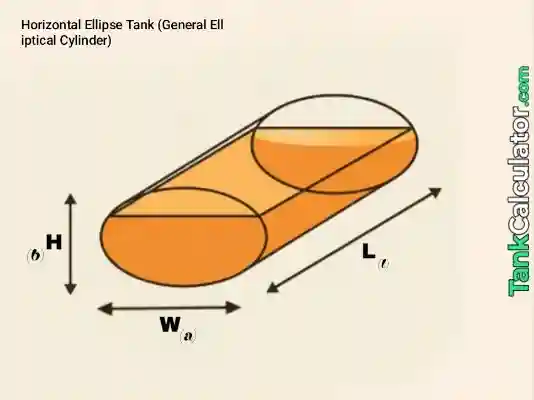
Formula: \( V = \pi \times \frac{\text{major}}{2} \times \frac{\text{minor}}{2} \times L = \pi a b L \) where \( a, b \) are semi-axes
Example inputs: major = 0.9 m, minor = 0.6 m, \( L = 0.9 \, \text{m} \)
Calculation:
- \( a = 0.45, b = 0.30 \)
- Area: \( \pi \times 0.45 \times 0.30\)
- \( = 0.4241152260 \, \text{m}^2 \)
- Volume: \( 0.4241152260 \times 0.9\)
- \( = 0.3817037034 \, \text{m}^3 \)
Convert to liters: \( 0.3817037034 \times 1000 = 381.704 \, \text{L} \)
10: Vertical Oval Stadium (flat tank heads)
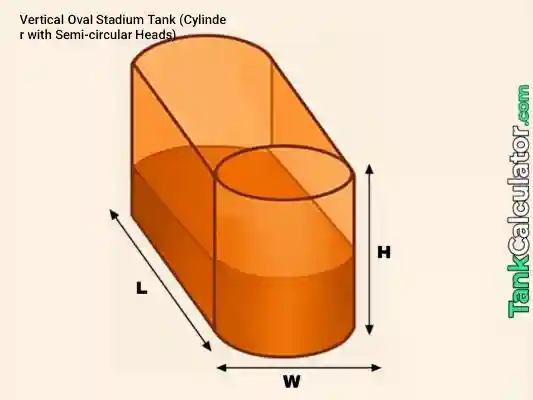
Geometry notes: Cross-section = two semicircles (radius \( r = W/2 \)) plus a central rectangle of height \( a = H – W \)
Formula: \( V = L (\pi r^2 + 2ra), r = \frac{W}{2}, a = H – W \)
Example inputs: \( W = 0.6 \, \text{m}, H = 0.9 \, \text{m}, L = 0.7 \, \text{m} \)
Calculation:
- \( r = 0.3 \, \text{m}, a = 0.9 – 0.6 = 0.3 \, \text{m} \)
- \( \pi r^2 = \pi \times 0.09 = 0.2827433388 \, \text{m}^2 \)
- \( 2ra = 2 \times 0.3 \times 0.3 = 0.18 \, \text{m}^2 \)
- Cross section area: \( 0.2827433388 + 0.18 \)
- \(= 0.4627433388 \, \text{m}^2 \)
- Volume: \( 0.4627433388 \times 0.7\)
- \( = 0.3239203372 \, \text{m}^3 \)
Convert to liters: \( 0.3239203372 \times 1000 = 323.920 \, \text{L} \)
11: Horizontal Oval Stadium (flat tank cross section)
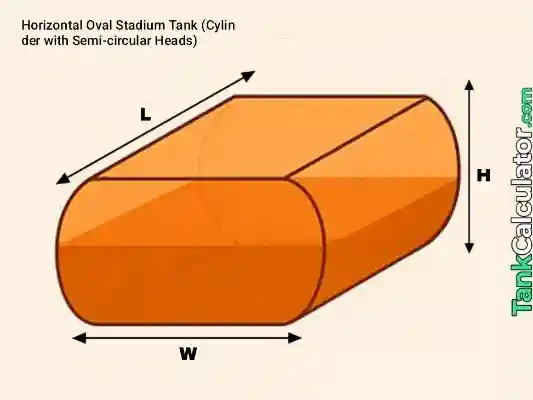
Geometry notes: Cross section = full circle (from two semicircles) of radius \( r = H/2 \) plus rectangular width \( a = W – H \)
Formula: \( V = L (\pi r^2 + a H), r = \frac{H}{2}, a = W – H \)
Example inputs: \( W = 1.0 \, \text{m}, H = 0.5 \, \text{m}, L = 0.6 \, \text{m} \)
Calculation:
- \( r = 0.25 \, \text{m}, a = 1.0 – 0.5 = 0.5 \, \text{m} \)
- \( \pi r^2 = \pi \times 0.0625 = 0.1963495408 \, \text{m}^2 \)
- \( a \times H = 0.5 \times 0.5 = 0.25 \, \text{m}^2 \)
- Cross section area: \( 0.1963495408 + 0.25 \)
- \( = 0.4463495408 \, \text{m}^2 \)
- Volume: \( 0.4463495408 \times 0.6 \)
- \(= 0.2678097245 \, \text{m}^3 \)
Convert to liters: \( 0.2678097245 \times 1000 = 267.810 \, \text{L} \)
12: Horizontal Cylinder with Dish Ends
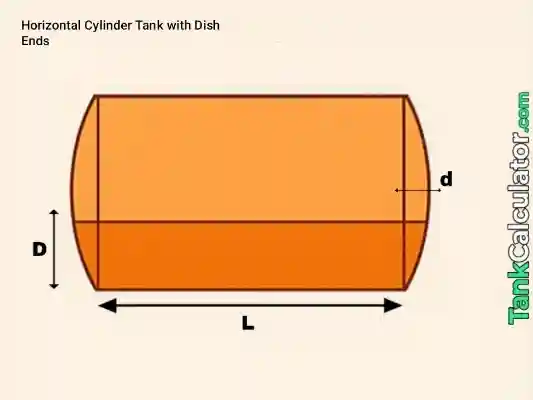
Formula: \( V = \pi r^2 L_c + 2 \cdot V_{\text{cap}}, \quad V_{\text{cap}} = \pi d^2 \frac{(3R – d)}{3} \)
Example inputs: Diameter (\( D \)) = 0.6 m, Cylinder length (\( L_c \)) = 0.5 m, Dish depth (\( d \)) = 0.1 m, Radius (\( r = R = \frac{D}{2} \)) = 0.3 m
Calculation:
- Cylinder volume: \( \pi r^2 L_c = \pi \times (0.3)^2 \times 0.5\)
- \(= \pi \times 0.09 \times 0.5 \)
- \(\approx 0.1413716694 \, \text{m}^3 \)
- Cap volume (one cap): \( V_{\text{cap}} = \pi \times (0.1)^2 \times \frac{(3 \times 0.3 – 0.1)}{3}\)
- \( = \pi \times 0.01 \times \frac{0.8}{3} \)
- \(\approx 0.0083775804 \, \text{m}^3 \)
- Two caps: \( 2 \times 0.0083775804\)
- \( \approx 0.0167551608 \, \text{m}^3 \)
Total: \( 0.1413716694 + 0.0167551608 \)
\(\approx 0.1581268302 \, \text{m}^3 \)
Convert to liters: \( 0.1581268302 \times 1000 \approx 158.127 \, \text{liters}\)
13: Spherical Tank
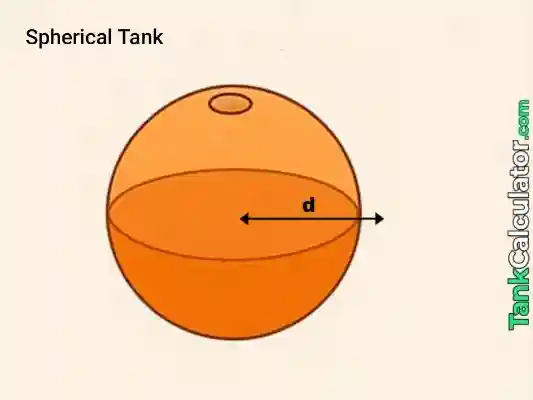
Formula: \( V = \frac{4}{3} \pi r^3 \) with \( r = D/2 \)
Example inputs: \( D = 0.8 \, \text{m} \)
Calculation:
- \( r = 0.4 \, \text{m} \)
- \( r^3 = 0.064 \)
- \( V = \frac{4}{3} \pi \times 0.064 \)
- \(= 0.2680825731 \, \text{m}^3 \)
Convert to liters: \( 0.2680825731 \times 1000 = 268.083 \, \text{L} \)
14: Cylinder with Cone Bottom
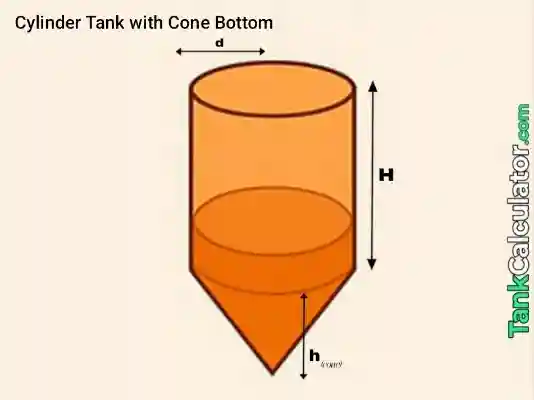
Formula: \( V = \pi r^2 H_{cyl} + \frac{1}{3} \pi r^2 H_{cone} \)
Example inputs: \( D = 0.6 \, \text{m}, H_{cyl} = 0.6 \, \text{m}, H_{cone} = 0.3 \, \text{m} \)
Calculation:
- \( r = 0.3 \, \text{m}, r^2 = 0.09 \)
- Cylinder: \( \pi r^2 H_{cyl} = \pi \times 0.09 \times 0.6\)
- \( = 0.1696460033 \, \text{m}^3 \)
- Cone: \( \frac{1}{3} \pi r^2 H_{cone} = \frac{1}{3} \pi \times 0.09 \times 0.3 \)
- \(= 0.0282743339 \, \text{m}^3 \)
Total: \( 0.1696460033 + 0.0282743339 \)
\(= 0.1979203372 \, \text{m}^3 \)
Convert to liters: \( 0.1979203372 \times 1000 = 197.920 \, \text{L} \)
These aren’t exotic math tricks. They’re just standard geometry applied to practical problems.
Features and Benefits of a Water Tank Capacity Calculator
So why bother with a water tank capacity calculator instead of doing it by hand? Here is what stands out:
- Multiple shapes covered. From basic boxes to tricky capsule or dish end tanks, you don’t need to remember different formulas.
- Unit flexibility. Input dimensions in meters, centimeters, inches or feet. The tool automatically converts everything to cubic meters before calculating.
- Instant conversions. Once the volume is known, you get it in liters, US gallons, UK gallons and cubic feet. No more searching conversion tables.
- Printable and exportable results. You can print your results or download them as a CSV file, handy for engineers, plumbers or students working on reports.
- User friendly. It is designed for anyone whether you are a farmer checking tank size, a builder planning a water supply system or just curious about your rain barrel.
Which is the Best Water Tank Company in India?
If you’re setting up a new home or replacing an old tank, the question comes up quickly: which brand should I trust? After all, a water tank is not something that you change every year. You want it to be safe, sturdy, hassle free and durable.
In India, the best water tanks usually share a few qualities: they are made of food grade plastic (so the water does not pick up taste or smell), they have UV protection (so the sun doesn’t wear them out) and they often come with multiple layers to keep the water cool and clean in sunny days.
A few names keep coming up in conversations link: Sintex, Supreme, Vectus, Ashirvad and Plasto. They have been around for years and each has its own strengths. Let’s compare them side by side:
| Brand | Why People Choose It | Typical Tank Sizes |
| Sintex | The “household name.” Tough, UV-stable, and widely available. | 500L – 20,000L |
| Supreme | Reliable plastic quality and long lifespan. Great for big family homes. | 500L – 10,000L |
| Vectus | Sleek designs plus durability. Good if you care about looks too. | 500L – 5,000L |
| Ashirvad | Premium tanks with anti-microbial coating for cleaner water. | 500L – 10,000L |
| Plasto | Budget-friendly option that’s easy to find locally. | 500L – 5,000L |
Frequently Asked Questions (FAQ)
How to calculate tank size?
Start simple: you need the tank’s shape and dimensions. For example, if it is a cylindrical tank than measure the radius (half the diameter) and the height. Then use the formula:
Volume = 3.14 × r² × h
How to calculate water tank capacity?
Capacity is just another way of saying “how much water your tank can hold.” Take the tank’s volume (from the formula based on its shape) and convert it into liter or gallon. For example: 1 cubic meter (m³) is equals to 1000 liter. So, if your cylindrical water tank works out to 2.5 m³ that’s 2500 liters. Many online calculators will do this conversion for you automatically, so you don’t need to mess with the math every time.
What shapes can a tank calculator handle?
Most calculators cover the common ones: rectangular, cylindrical (horizontal and vertical) and spherical. Some advanced ones even handle more unusual designs, like oval or capsule shaped tanks. So whether it is a small overhead water tank in your house or a massive industrial tank, there’s usually a calculator that can handle it easily.
How to select water tank size?
Think about two things: your daily water needs and how often you will refill the tank. For a small familys a 500 to 1000 liter tank often works fine. If you live in an area with irregular water supply than you’ll need more storage maybe 2000 liters or above. Also, consider space on your property because A tank too big for your rooftop or yard just creates problems.
What is the best water tank size?
There’s no one size fits all answer. For a single person or couple 500 liters might be plenty. A family of four often finds 1000 to 2000 liters ideal. Larger households or small businesses may need 5000 liters or more. The “best” size is the one that balances your water usage, budget and available space.
What is the safest material for a water tank?
The most common and safe options are food grade plastic (HDPE), stainless steel and concrete. Plastic tanks are affordable, lightweight and widely used. Stainless steel lasts longer, resists rust and keeps water cooler but it’s too costly. Concrete tanks are durable for underground storage but harder to maintain. If your main concern is safe drinking water, food grade plastic or stainless steel are usually recommended. Always check that the tank is BPA free and ISI certified or certified for potable water storage.
